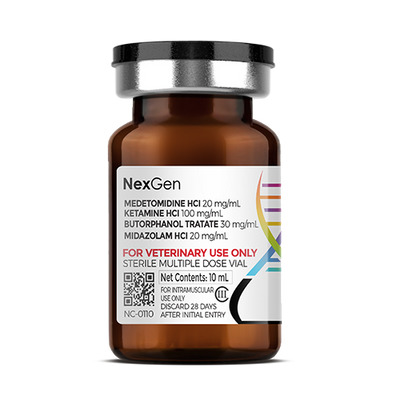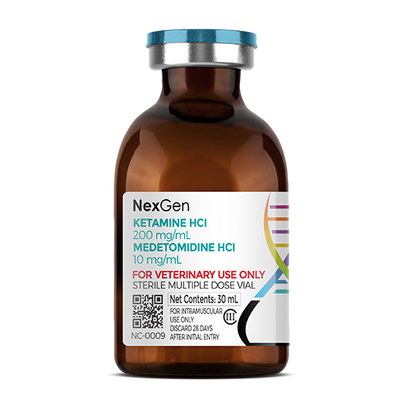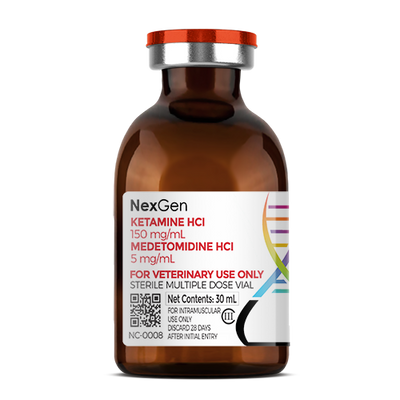
MKB2™ (Medetomidine HCl 20 mg/mL + Ketamine HCl 100 mg/mL + Butorphanol Tartrate 50 mg/mL), Injectable Solution, 10mL
Login for pricing
- Brand
- Mixlab
- SKU:
- NC-0136
- Product Type:
- Injectable
- Administration:
- Intramuscular
- Size:
- 10ml
- Controlled Substance:
- Schedule CIII
Information gained from the capture and handling of free-ranging animals helps advance the understanding of wildlife ecology and aids in crafting wildlife management policy. Unfortunately, animals can experience increased levels of stress, injuries, and death resulting from captures.1 Fortunately, some of the above information has also helped immeasurably in the development of drug formulations that actually decrease the risks associated with capture and chemical immobilization. Since the advent of modern chemical immobilization techniques, developing drug formulations that address both the physiological attributes of individual species as well as the effects of the varied and numerous conditions encountered in the field have been among the chief objectives of wildlife veterinarians, wildlife managers, researchers and the veterinary pharmaceutical industry.
Preparation for the chemical restraint of an animal in the field must often be made without the benefit of a physical examination to determine the animal’s physiological condition or needs. Thus, the need for drug formulations that adhere to these parameters is even more important, from both practical and ethical standpoints. The ideal immobilization drug formulations for wild and exotic animals should have a wide safety margin, small volume for delivery, and be fully reversible; thus, a small volume will facilitate rapid administration especially if remote delivery systems are used.2,3 Since the refinement of drug formulations has been a dedicated concern of those working with wildlife over the last several decades, the custom formulas available today are far superior to the drugs and formulations used in years past.
The MKB2™ Formulation
The MKB2™ formulation by NexGen Pharmaceuticals is a premixed formulation developed to provide veterinarians and wildlife handlers with a field-tested immobilization anesthesia option that can be effectively used to immobilize a broad range of exotic animal species. It is particularly effective in the chemical immobilization of large cervids, such as elk, deer, fallow deer, white-tailed deer, roe deer and many others.
With higher concentrations of medetomidine, ketamine and butorphanol than NexGen’s MKB™ formulation, MKB2™ provides longer and deeper sedation, which translates into extended working time and quick recovery.
MKB2™ contains:
-
Medetomidine 20 mg/ml
-
Ketamine 100 mg/ml /
-
Butorphanol 50 mg/ml
General anesthesia poses increased risks for larger exotic species, such as cardiorespiratory depression, myopathy, and hyperthermia. In ruminants, ruminal bloat and regurgitation of rumen contents with potential aspiration pneumonia are added risks. Thus, the use of heavy sedation such as is provided by butorphanol is justified for these species.5 Generally, there is minimal cardiopulmonary depression with its use compared with other opioids and, at lower doses, there is a dose-dependent effect on respiratory depression but then a ceiling is reached and no further respiratory depression occurs.
Delivery and Recommendations
For those who are new to utilizing the MKB2™ formulation, it is important to understand the level of anesthesia administered. MKB2™ is a deep sedation, not to be confused with other sedations that are moderate. By using the MKB2™ kit, wildlife handlers are able to induce a reversible sedation, with induction times ranging from 3 to 5 minutes and working times of 10 to15 minutes. The benefits of using these sedations is the ability for the animal to recover on its own if the handler does happen to lose the animal after darting it. MKB2™ offers smooth induction with faster reversal times than regular MK formulations due to the lower concentration of ketamine.
The preferred route for the administration of an immobilizing drug by remote delivery is via intramuscular injection. The aim is to hit the animal in a specifically-selected site, causing injection into vascular tissue and facilitating rapid absorption of the drug. Not all areas of an animal's body are equally well-suited for injection by remote delivery; thus, the injection site should be carefully chosen.
The neck is generally a suitable site for large animals with muscular necks. Care should be taken to avoid hitting the jugular vein, the upper neck and the head. The ideal injection site is the trapezius muscle mass at the upper base of the neck. This injection site is suitable for species such as elk, moose, buffalo, bear, the equids and larger antelopes, rhinoceros, hippopotamus and elephant (if the ears can be avoided). Animals with slender necks, such as gazelle, gerenuk, giraffe and impala should not be darted in this area.
The shoulder is a suitable injection site in many larger species. This region is well-muscled, presenting a flat, perpendicular target. It is surrounded by relatively resilient areas and presents a fair-sized target in animals that are robust enough to be darted with remote delivery equipment.
To prevent the needle from becoming embedded in cartilage, the upper end of the scapula should be avoided. In sensitive species, the sight and smell of a dart in the shoulder may cause panic and flight. Some carnivores will destroy the dart by pulling it out with their teeth. The shoulder is not a suitable injection site for smaller species, due to their lesser size and limited muscle mass.
Where to buy the MKB2™ Formulation
FOR RX ONLY: A valid prescription from a licensed veterinarian is required for dispensing this medication.
1Ortega, A., et. al. Effectiveness of Partial Sedation to Reduce Stress in Captured Mule Deer. Journal of Wildlife Management, July 2020.
2West, G., et. al. Zoo Animal and Wildlife Immobilization and Anesthesia, Second Edition, John Wiley & Sons, Inc., July 2014.
3Arnemo, Jon & Kreeger, Terry. (2018). Handbook of Wildlife Chemical Immobilization, 5th Ed.
4Nielsen, L. Chemical immobilization of wild and exotic animals, Ames: Iowa State University Press, 1999.




















